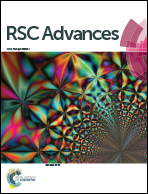Facile one-pot method of AuNPs/PEDOT/CNT composites for simultaneous detection of dopamine with a high concentration of ascorbic acid and uric acid
Abstract
In this research, a facile one-pot method was used to synthesize gold/poly-3,4-ethylene-dioxythiophene/carbon nanotube (AuNPs/PEDOT/CNTs) composite material. The composite material was investigated by Fourier Transform Infrared spectroscopy (FTIR), X-ray diffraction (XRD) and Scanning Electron Microscopy (SEM). Then the synthesized nanocomposite material was dropped on a bare glassy carbon electrode (GCE) to improve the detection performance of dopamine with a high concentration of ascorbic acid and uric acid. The electrochemical behavior of AuNPs/PEDOT/CNTs/GCE was studied by Cyclic Voltammetry (CV), Differential Pulse Voltammetry (DPV) and electrochemical impedance spectroscopy (EIS). Under optimum conditions, AuNPs/PEDOT/CNTs/GCE showed a good linear response in the concentration range from 9.14 to 29.704 μM with a detection limit (LOD) and sensitivity of 0.283 μM and 1.557 μA μM−1, respectively. This sensor was applied to detect practical samples with good average recovery. It also exhibited good reproducibility and stability.



 Please wait while we load your content...
Please wait while we load your content...